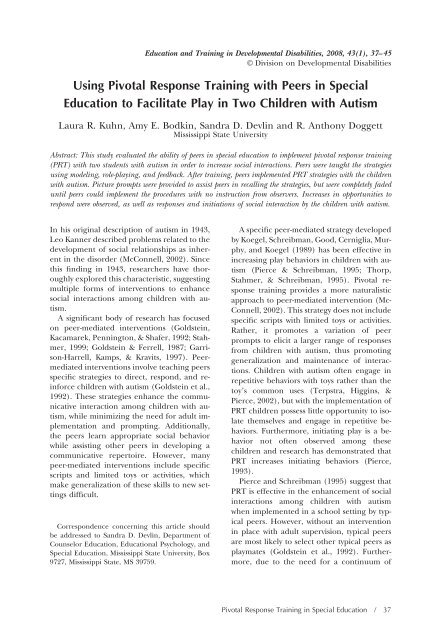Download the Journal (PDF) - Division on Autism and ...
Download the Journal (PDF) - Division on Autism and ...
Download the Journal (PDF) - Division on Autism and ...
Create successful ePaper yourself
Turn your PDF publications into a flip-book with our unique Google optimized e-Paper software.
Using Pivotal Resp<strong>on</strong>se Training with Peers in Special<br />
Educati<strong>on</strong> to Facilitate Play in Two Children with <strong>Autism</strong><br />
Laura R. Kuhn, Amy E. Bodkin, S<strong>and</strong>ra D. Devlin <strong>and</strong> R. Anth<strong>on</strong>y Doggett<br />
Mississippi State University<br />
Abstract: This study evaluated <str<strong>on</strong>g>the</str<strong>on</strong>g> ability of peers in special educati<strong>on</strong> to implement pivotal resp<strong>on</strong>se training<br />
(PRT) with two students with autism in order to increase social interacti<strong>on</strong>s. Peers were taught <str<strong>on</strong>g>the</str<strong>on</strong>g> strategies<br />
using modeling, role-playing, <strong>and</strong> feedback. After training, peers implemented PRT strategies with <str<strong>on</strong>g>the</str<strong>on</strong>g> children<br />
with autism. Picture prompts were provided to assist peers in recalling <str<strong>on</strong>g>the</str<strong>on</strong>g> strategies, but were completely faded<br />
until peers could implement <str<strong>on</strong>g>the</str<strong>on</strong>g> procedures with no instructi<strong>on</strong> from observers. Increases in opportunities to<br />
resp<strong>on</strong>d were observed, as well as resp<strong>on</strong>ses <strong>and</strong> initiati<strong>on</strong>s of social interacti<strong>on</strong> by <str<strong>on</strong>g>the</str<strong>on</strong>g> children with autism.<br />
In his original descripti<strong>on</strong> of autism in 1943,<br />
Leo Kanner described problems related to <str<strong>on</strong>g>the</str<strong>on</strong>g><br />
development of social relati<strong>on</strong>ships as inherent<br />
in <str<strong>on</strong>g>the</str<strong>on</strong>g> disorder (McC<strong>on</strong>nell, 2002). Since<br />
this finding in 1943, researchers have thoroughly<br />
explored this characteristic, suggesting<br />
multiple forms of interventi<strong>on</strong>s to enhance<br />
social interacti<strong>on</strong>s am<strong>on</strong>g children with autism.<br />
A significant body of research has focused<br />
<strong>on</strong> peer-mediated interventi<strong>on</strong>s (Goldstein,<br />
Kacamarek, Penningt<strong>on</strong>, & Shafer, 1992; Stahmer,<br />
1999; Goldstein & Ferrell, 1987; Garris<strong>on</strong>-Harrell,<br />
Kamps, & Kravits, 1997). Peermediated<br />
interventi<strong>on</strong>s involve teaching peers<br />
specific strategies to direct, resp<strong>on</strong>d, <strong>and</strong> reinforce<br />
children with autism (Goldstein et al.,<br />
1992). These strategies enhance <str<strong>on</strong>g>the</str<strong>on</strong>g> communicative<br />
interacti<strong>on</strong> am<strong>on</strong>g children with autism,<br />
while minimizing <str<strong>on</strong>g>the</str<strong>on</strong>g> need for adult implementati<strong>on</strong><br />
<strong>and</strong> prompting. Additi<strong>on</strong>ally,<br />
<str<strong>on</strong>g>the</str<strong>on</strong>g> peers learn appropriate social behavior<br />
while assisting o<str<strong>on</strong>g>the</str<strong>on</strong>g>r peers in developing a<br />
communicative repertoire. However, many<br />
peer-mediated interventi<strong>on</strong>s include specific<br />
scripts <strong>and</strong> limited toys or activities, which<br />
make generalizati<strong>on</strong> of <str<strong>on</strong>g>the</str<strong>on</strong>g>se skills to new settings<br />
difficult.<br />
Corresp<strong>on</strong>dence c<strong>on</strong>cerning this article should<br />
be addressed to S<strong>and</strong>ra D. Devlin, Department of<br />
Counselor Educati<strong>on</strong>, Educati<strong>on</strong>al Psychology, <strong>and</strong><br />
Special Educati<strong>on</strong>, Mississippi State University, Box<br />
9727, Mississippi State, MS 39759.<br />
Educati<strong>on</strong> <strong>and</strong> Training in Developmental Disabilities, 2008, 43(1), 37–45<br />
© <str<strong>on</strong>g>Divisi<strong>on</strong></str<strong>on</strong>g> <strong>on</strong> Developmental Disabilities<br />
A specific peer-mediated strategy developed<br />
by Koegel, Schreibman, Good, Cerniglia, Murphy,<br />
<strong>and</strong> Koegel (1989) has been effective in<br />
increasing play behaviors in children with autism<br />
(Pierce & Schreibman, 1995; Thorp,<br />
Stahmer, & Schreibman, 1995). Pivotal resp<strong>on</strong>se<br />
training provides a more naturalistic<br />
approach to peer-mediated interventi<strong>on</strong> (Mc-<br />
C<strong>on</strong>nell, 2002). This strategy does not include<br />
specific scripts with limited toys or activities.<br />
Ra<str<strong>on</strong>g>the</str<strong>on</strong>g>r, it promotes a variati<strong>on</strong> of peer<br />
prompts to elicit a larger range of resp<strong>on</strong>ses<br />
from children with autism, thus promoting<br />
generalizati<strong>on</strong> <strong>and</strong> maintenance of interacti<strong>on</strong>s.<br />
Children with autism often engage in<br />
repetitive behaviors with toys ra<str<strong>on</strong>g>the</str<strong>on</strong>g>r than <str<strong>on</strong>g>the</str<strong>on</strong>g><br />
toy’s comm<strong>on</strong> uses (Terpstra, Higgins, &<br />
Pierce, 2002), but with <str<strong>on</strong>g>the</str<strong>on</strong>g> implementati<strong>on</strong> of<br />
PRT children possess little opportunity to isolate<br />
<str<strong>on</strong>g>the</str<strong>on</strong>g>mselves <strong>and</strong> engage in repetitive behaviors.<br />
Fur<str<strong>on</strong>g>the</str<strong>on</strong>g>rmore, initiating play is a behavior<br />
not often observed am<strong>on</strong>g <str<strong>on</strong>g>the</str<strong>on</strong>g>se<br />
children <strong>and</strong> research has dem<strong>on</strong>strated that<br />
PRT increases initiating behaviors (Pierce,<br />
1993).<br />
Pierce <strong>and</strong> Schreibman (1995) suggest that<br />
PRT is effective in <str<strong>on</strong>g>the</str<strong>on</strong>g> enhancement of social<br />
interacti<strong>on</strong>s am<strong>on</strong>g children with autism<br />
when implemented in a school setting by typical<br />
peers. However, without an interventi<strong>on</strong><br />
in place with adult supervisi<strong>on</strong>, typical peers<br />
are most likely to select o<str<strong>on</strong>g>the</str<strong>on</strong>g>r typical peers as<br />
playmates (Goldstein et al., 1992). Fur<str<strong>on</strong>g>the</str<strong>on</strong>g>rmore,<br />
due to <str<strong>on</strong>g>the</str<strong>on</strong>g> need for a c<strong>on</strong>tinuum of<br />
Pivotal Resp<strong>on</strong>se Training in Special Educati<strong>on</strong> / 37
















